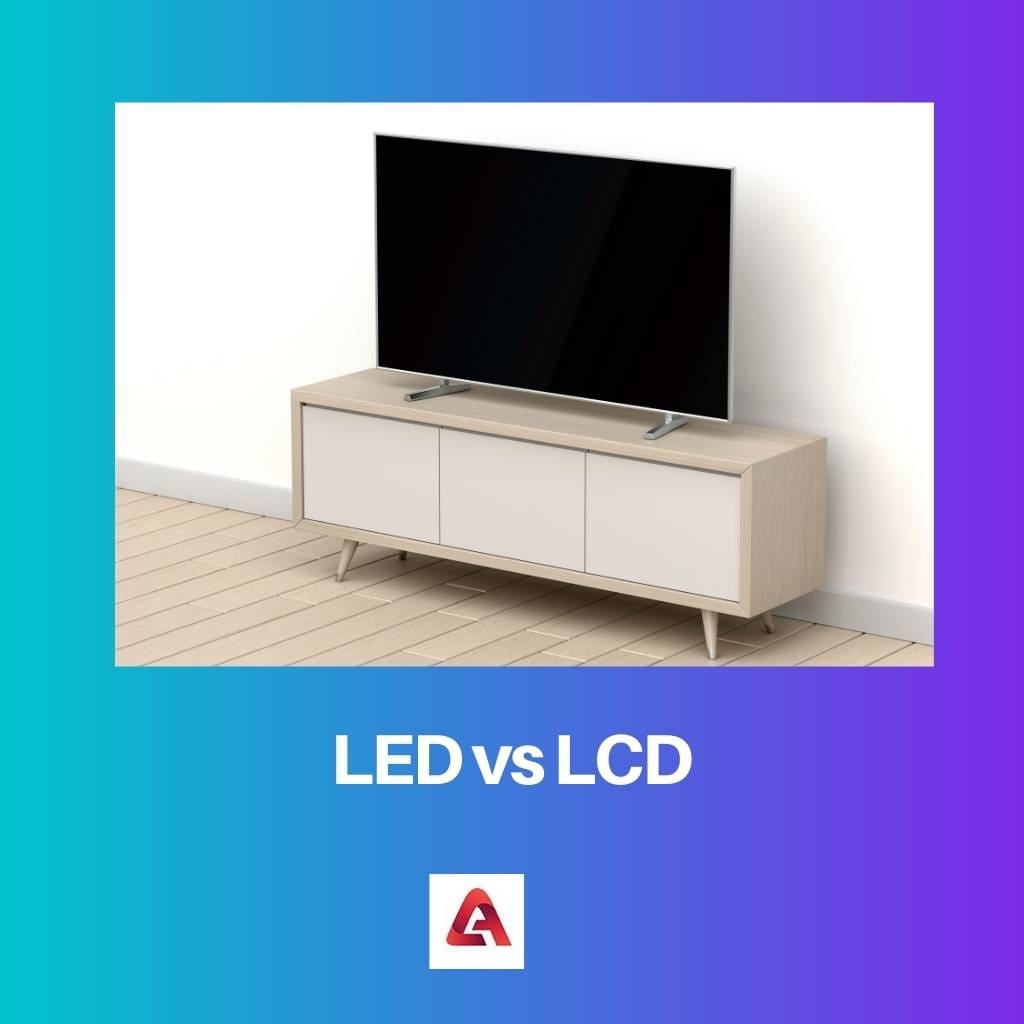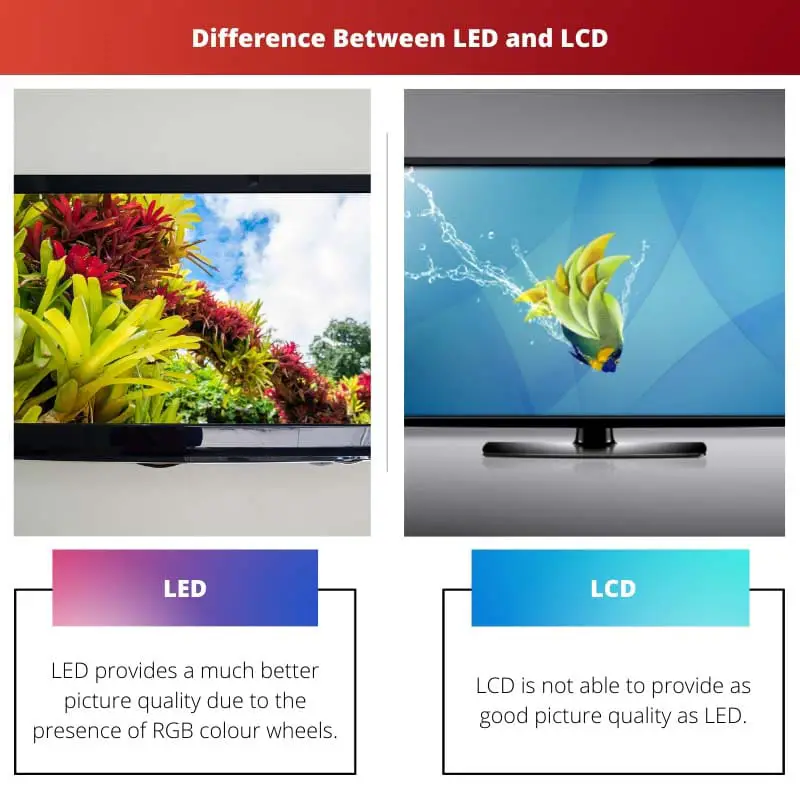We are living in an era of advanced technology where people are making use of technology in the best possible way to excel in every domain of life.
Key Takeaways
- LED displays use light-emitting diodes for backlighting, and LCDs use liquid crystals and fluorescent lamps.
- LED displays consume less power, offer better color accuracy, and have higher contrast ratios.
- LED technology is newer and more expensive than LCD.
LED vs LCD
LED displays produce images using light-emitting diodes, which are small semiconductor devices emitting light when an electric current passes through them. LCD displays use technology with liquid crystals to produce images. They are known for their sharp image quality and color accuracy.

LED can be categorized as a subset of LCD, which is in great demand nowadays for the manufacturing of electronic devices as it has a very long life, provides the best picture quality, and also has a high-definition output.
LCD, which was in great use a few years back, has become outdated due to the invention of LED. LCD is basically a submissive device that uses fluorescent tubes to lighten the image.
Comparison Table
| Parameters of Comparison | LED | LCD |
|---|---|---|
| Picture Quality | LED provides a much better picture quality due to the presence of RGB colour wheels. | LCD is not able to provide as good picture quality as LED. |
| Price | LED’s are costlier than LCDs. | LCD’s are cheap in comparison. |
| Lifespan | The average lifespan of LED is close to 1,00,000 hours. | The average lifespan of LCD is close to 75000 hours. |
| Power Efficiency | LED’s are highly power effective and consume comparatively less power. | LCDs are less power efficient and utilize more power. |
| Environment Friendly | LED does not pose any harm to the environment as no mercury is used for the production of LED. | LCD is a great threat to nature as mercury is used in its manufacturing. |
What is LED?
Light Emitting Diode (LED) is an indication of how technology has reached new heights in the modern world. It has displaced the fluorescent tubing with backlight technology which helps it deliver a precise and clear image.
LED is basically used in the manufacturing of computer monitors, Bulbs, and Televisions. LED televisions are in great demand now due to the extraordinary features and benefits which they provide.
It works on the principle of Electroluminescence. Light in a LED is produced when particles carrying current, also known as electrons and holes, come collectively within the material of the semiconductor.
Gamers use LED screens for playing high graphic games as LED screens have a much better contrast in comparison to LCD screens.

What is LCD?
Liquid Crystal Display (LCD) is made of a material called Liquid Crystal which is a type of substance that is neither liquid nor solid but comes somewhere in the middle of these two.
There are, in general, three types of LCD TVs that are Flat screen LCDs, Front Projection LCDs, and Rear projection LCDs.
There are numerous disadvantages of LCD like it has an unusual refresh frequency and it also suffers from action blur consequences.
The major elements that are necessary for displaying an image on the LCD screen are Light, color and the method to regulate the light and colors on the screen.

Main Differences Between LED and LCD
- LEDs work on the well-known principle of Electroluminescence, whereas all LCDs function on the basic principle of blocking light energy.
- If we discuss the relevance of LED and LCD in the modern era, then LED are much more relevant and in use than LCD.

- https://www.tandfonline.com/doi/abs/10.1080/15421400802240698
- https://ieeexplore.ieee.org/abstract/document/4292350/
- https://www.nature.com/articles/nphoton.2009.32

The explanation of the working principles of LED and LCD displays is quite clear and detailed. LED’s use of Electroluminescence to produce light makes it more advanced and suitable for various applications. The advantages and disadvantages of both LED and LCD are well presented in the article.
LED is a technology that makes great use of the principles of Electroluminescence. It offers better color accuracy, higher contrast ratios and consumes less power, making it more efficient. It is great to see the advancements in technology that have led to the development of LED displays. Highly informative article.
The article helps to gain an understanding of the differences between LED and LCD displays, particularly in terms of picture quality, price, lifespan, and environmental impact. The detailed description of the technologies and the comparison table are very helpful for someone looking to choose between LED and LCD displays.
The comparison table provided showcases the differences between LED and LCD displays quite effectively. The fact that LED displays offer a much better picture quality due to the presence of RGB colour wheels is quite interesting. Moreover, the absence of mercury in LED displays makes them more environment friendly than LCD displays.
It’s interesting to learn that LED televisions are in great demand due to the features and benefits they provide, such as the precise and clear image quality. The reference links provided at the end are also useful for those who want to explore the topic further.
The article provides insightful details about LED and LCD displays. The explanation of Light Emitting Diode (LED) and Liquid Crystal Display (LCD), their uses and the technology behind them is very informative.
The comparison of LED and LCD displays in terms of picture quality, price, lifespan, and power efficiency is insightful. The information provided about the relevance and use of LED in the modern era is particularly interesting and shows how LED technology has surpassed LCD in many aspects.
LED is a much more expensive than LCD displays due to the technology used and it is power efficient. It is interesting to note that LED technology is newer than LCD and has few advantages. The average lifespan of LED is close to 1,00,000 hours, longer than that of the LCD displays. Technologically speaking, LED is the future of displays.
The article explains the key differences between LED and LCD displays with clear and concise information. The references provided at the end add credibility to the content. Overall, it’s an enlightening read for those interested in understanding the advancements in display technologies.
The detailed description of the working principles of LED and LCD displays provides a clear understanding of the technologies. The references listed at the end of the article are useful for further exploration of the topic. This article is a great resource for understanding the differences between LED and LCD displays.